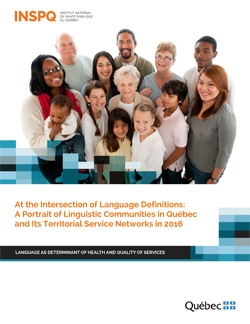At the Intersection of Language Definitions: A Portrait of Linguistic Communities in Québec and Its Territorial Service Networks in 2016
The Integrated Health and Social Services Centres (CISSS) and Integrated University Health and Social Services Centres (CIUSSS) are at the center of the twenty-two territorial service networks (RTS). The RTS are responsible for providing health care and services to their population, which includes minority linguistic communities that may face communicational obstacles.
In this report, the variables "mother tongue", "language spoken at home" and "knowledge of official languages" from the 2016 census, as well as their intersection, were analyzed for the population of Quebec and that of the RTS.
Overall this report confirms the presence of potential linguistic barriers among minority linguistic communities and shows that those communities served by RTS institutions are quite heterogeneous.
Overview
- In 2016, the population of Québec was 78% francophone as defined by mother tongue or 81% as defined by language spoken at home. Anglophones and allophones are language minorities: about 10% of Québec residents speak English at home and 7% speak a language other than English or French.
- While close to 95% of the province’s population can conduct a conversation in French, the remaining 5.5% cannot communicate in French, which translates to 454,000 people.
Correspondence between mother tongue and language spoken at home
- For Québec as a whole, there is high concordance between mother tongue and language spoken most often at home among francophones (94%) and allophones (93%).
- But concordance is lower for persons who speak English most often at home. Only 65% of this group reported English as their mother tongue. Onequarter (24%) has a mother tongue that is not one of the official languages, while the remainder are native speakers of French (9%) or are bilingual in English and French (2%).
Language shifts
- There are more people speaking French at home than having French as their mother tongue. That is what we call a language shift. The same pattern is also observed for people speaking English at home. This probably implies that some people whose mother tongue is neither French or English take on French or English as their language spoken at home later in life.
Knowledge of official languages and correspondence with language spoken at home
- A cross-tabulation of language spoken at home with knowledge of official languages reveals that 30% of anglophones (255,000) can only speak English.
- About 13% of allophones in Québec (about 75,000 people) cannot speak English or French.
- Language minorities who cannot speak French primarily live in the RTSs of Montréal, Laval, and Montérégie, but are present in every RTS in the province (see maps in Section 3.2.2).


